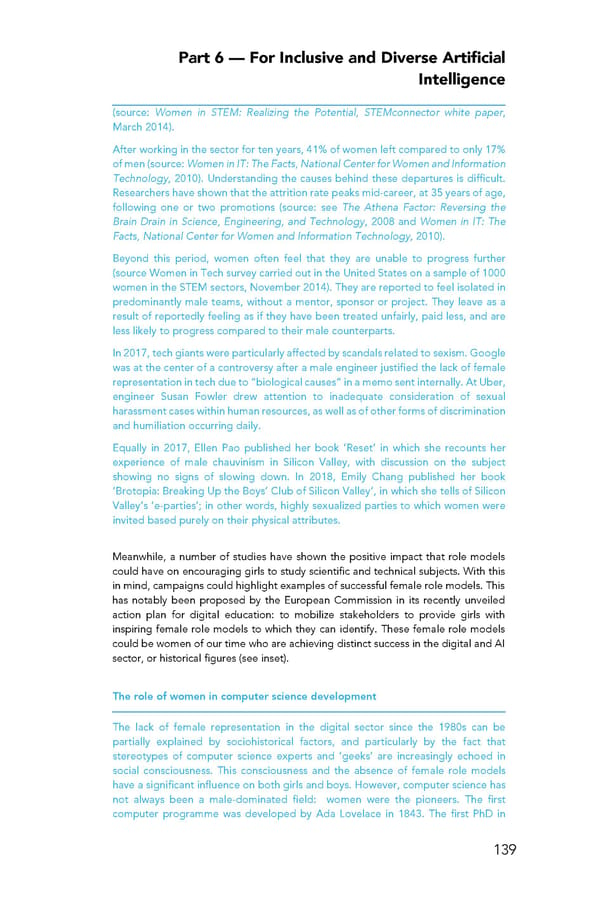Part 6 — For Inclusive and Diverse Artificial Intelligence (source: Women in STEM: Realizing the Potential, STEMconnector white paper, March 2014). After working in the sector for ten years, 41% of women left compared to only 17% of men (source: Women in IT: The Facts, National Center for Women and Information Technology, 2010). Understanding the causes behind these departures is difficult. Researchers have shown that the attrition rate peaks mid-career, at 35 years of age, following one or two promotions (source: see The Athena Factor: Reversing the Brain Drain in Science, Engineering, and Technology, 2008 and Women in IT: The Facts, National Center for Women and Information Technology, 2010). Beyond this period, women often feel that they are unable to progress further (source Women in Tech survey carried out in the United States on a sample of 1000 women in the STEM sectors, November 2014). They are reported to feel isolated in predominantly male teams, without a mentor, sponsor or project. They leave as a result of reportedly feeling as if they have been treated unfairly, paid less, and are less likely to progress compared to their male counterparts. In 2017, tech giants were particularly affected by scandals related to sexism. Google was at the center of a controversy after a male engineer justified the lack of female representation in tech due to “biological causes” in a memo sent internally. At Uber, engineer Susan Fowler drew attention to inadequate consideration of sexual harassment cases within human resources, as well as of other forms of discrimination and humiliation occurring daily. Equally in 2017, Ellen Pao published her book ‘Reset’ in which she recounts her experience of male chauvinism in Silicon Valley, with discussion on the subject showing no signs of slowing down. In 2018, Emily Chang published her book ‘Brotopia: Breaking Up the Boys’ Club of Silicon Valley’, in which she tells of Silicon Valley’s ‘e-parties’; in other words, highly sexualized parties to which women were invited based purely on their physical attributes. Meanwhile, a number of studies have shown the positive impact that role models could have on encouraging girls to study scientific and technical subjects. With this in mind, campaigns could highlight examples of successful female role models. This has notably been proposed by the European Commission in its recently unveiled action plan for digital education: to mobilize stakeholders to provide girls with inspiring female role models to which they can identify. These female role models could be women of our time who are achieving distinct success in the digital and AI sector, or historical figures (see inset). The role of women in computer science development The lack of female representation in the digital sector since the 1980s can be partially explained by sociohistorical factors, and particularly by the fact that stereotypes of computer science experts and ‘geeks’ are increasingly echoed in social consciousness. This consciousness and the absence of female role models have a significant influence on both girls and boys. However, computer science has not always been a male-dominated field: women were the pioneers. The first computer programme was developed by Ada Lovelace in 1843. The first PhD in 139
 For a Meaningful AI - Report Page 137 Page 139
For a Meaningful AI - Report Page 137 Page 139